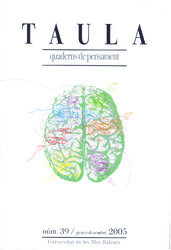|
Abstract:
|
[SPA] En quant a text, El concepte d’angoixa és una obra que es presenta com un tractat acadèmic que versa sobre l’angoixa i el pecat. No obstant això, l’obra no en diu res del pecat i de l’angoixa, ben poca cosa. Alguns especialistes de Kiekegaard fins han considerat aquesta contradicció com a símptoma característic de la ironia kiekergaardiana i afirmat que, en veritat, El concepte d’angoixa no és altra cosa que una paròdia dels llibres de text. Bo i recollint les principal interpretacions que s’han fet de l’obra, l’objectiu d’aquest article és demostrar que, abans de res, El concepte d’angoixa és un discurs poeticoliminar que apunta devers allò que justament no pot ser dit, ans únicament viscut en l’existència. El pecat és el límit de tot discurs, un buit en el llenguatge que necessita de l’existència de l’individu per a omplir-se. D’aquesta manera, , El concepte d’angoixa esdevé una comunicació indirecta més que, en comptes de presentar diverses opcions de vida, exigeix al lector una decisió respecte del pecat i de l’angoixa. ; [ENG] As text, The Concept of Anxiety is a work that shows itself as a learned treatise that deals with anxiety and sin. However, the work says nothing about sin, and very little about anxiety. Some Kierkegaard scholars have even regarded such contradiction as a characteristic symptom of the Kierkegaardian irony and stated that The Concept of Anxiety is, actually, nothing more than a parody of the academic textbooks. Giving account of the most important interpretations of the work, the aim of this paper is to show that, first and foremost, The Concept of Anxiety is a poetic-liminal discourse that points to what precisely cannot be said but only lived within existence. Sin is the limit of all discourse a void within language that needs the existence of the individual in order to be filled. Thus, The Concept of Anxiety is another indirect communication, which, instead of presenting various ways of life, requires of the reader a decision towards anxiety and sin. |

 El concepte d'angoixa de Søren Kierkegaard: tractat psicologicoteològic o bé obra indirecta?
El concepte d'angoixa de Søren Kierkegaard: tractat psicologicoteològic o bé obra indirecta?